Yakibuta (Braised Pork – Japanese Char Siu) is a large piece of pork cooked in soy flavoured sauce over a couple of hours. This is the pork for ramen! It takes time to cook but it is quite simple to make. The flavour penetrates into the meat and the meat is so tender and flavoursome. Slice thinly to serve as a main dish, appetiser or a topping for ramen.
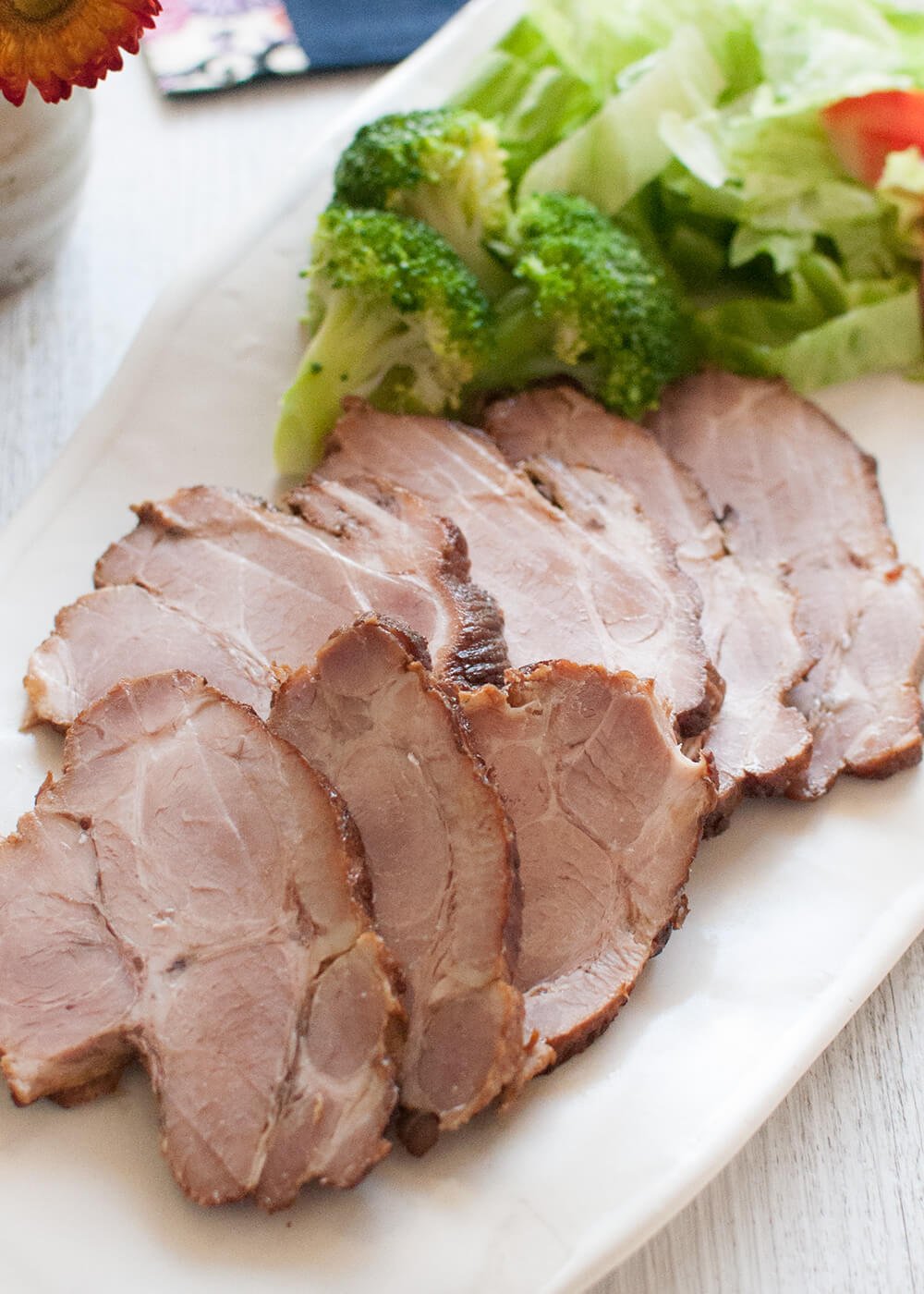
When you order a bowl of plain ramen at a Japanese noodle shop, it usually comes with a couple of slices of pork along with a few other toppings. This pork is yakibuta (braised pork).
Some people call today’s dish char siu (叉燒) but that is not quite accurate. Char siu is a Chinese barbequed pork and, as the name suggests, it is grilled after seasoning strips of pork. On the other hand, yakibuta (焼き豚) is made by searing a block of meat first, then cooking in soy-based sauce until tender. So I call it Japanese Char Siu.
It is understandable that people get confused about the name because the word “yaki” (焼き) means grill. So strictly speaking, this dish should actually be called nibuta (煮豚) meaning simmered pork, instead of yakibuta. But the word ‘yaki’ might have come from the fact that the pork is seared at the beginning.
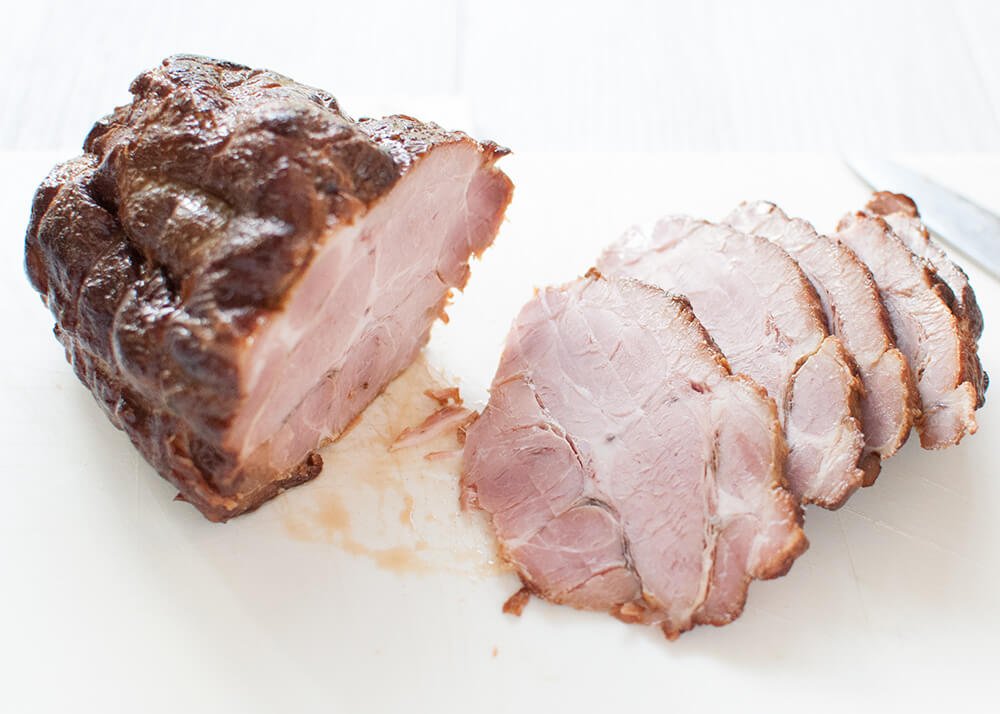
At ramen specialty shops, they often call yakibuta “char siu” even if it is the Japanese braised pork like the one in this recipe. Some people call even nibuta “char siu”. How confusing! So, when you hear the word “char siu” in Japan, you have to double check which one of the pork dishes it is – Chinese char siu, yakibuta or nibuta. all of them are tasty, though.
Unlike Chinese char siu, the block of pork used to make yakibuta is rather large, about 8 – 10cm (3½ – 4”) in diameter. But it becomes slightly thinner because the meat needs to be tied with string to tighten the flesh and help it stay in a round shape.
I used a block of pork scotch fillet (pork neck or pork collar) but you could use pork loin or pork belly. In the case of pork belly, you would need to roll it to make it into a log shape, then tie with strings. Here are the photos of yakibuta made with pork belly.
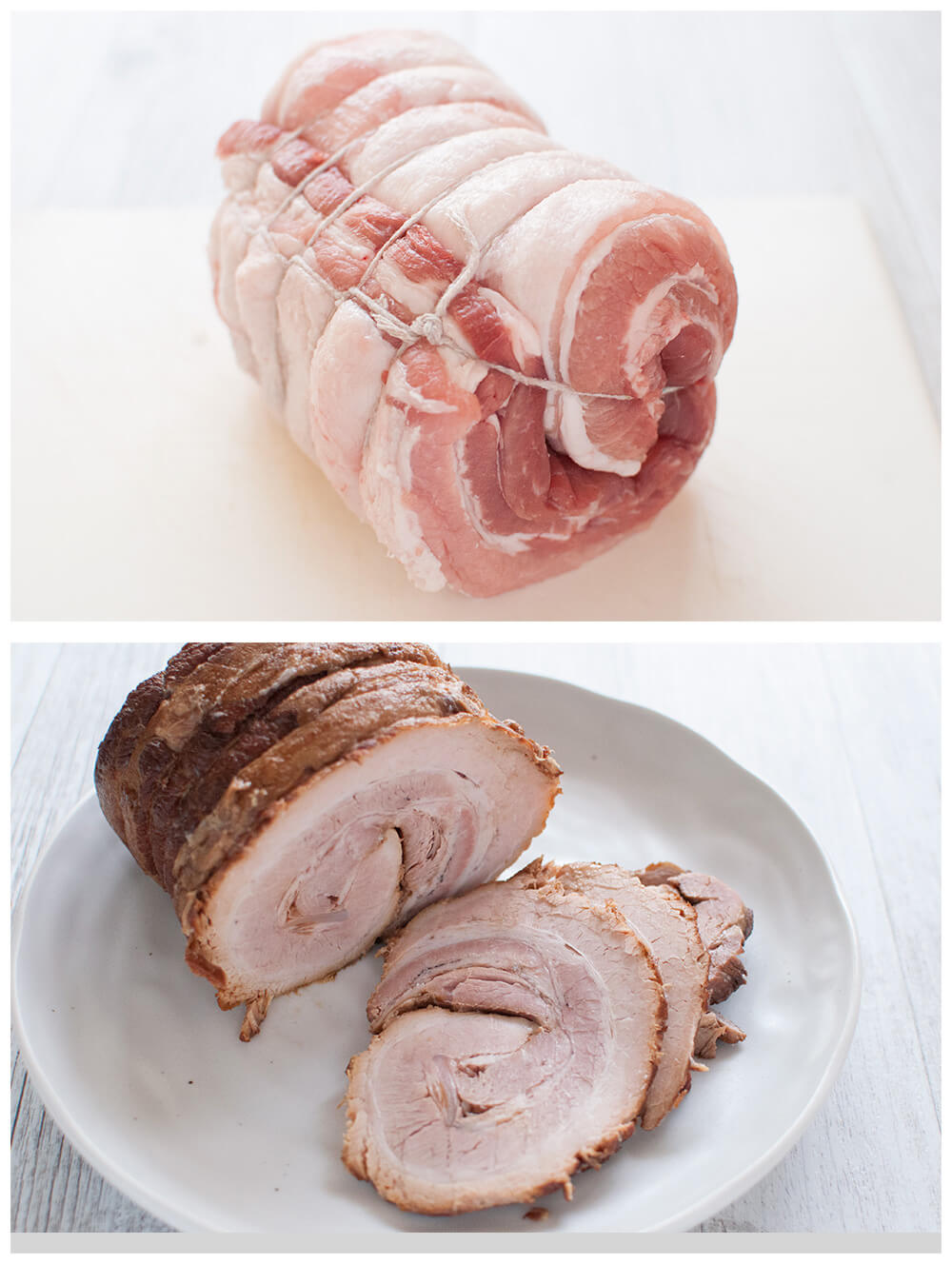
The photo below shows the steps to tie a block of pork scotch fillet (pork neck or pork collar), which is about 1kg (2.2lb). I missed one photo in the steps between 4 and 5 to show how to pull the string to tighten up the meat. Sorry about that. You just have to pull the remaining string to tighten it around the meat.
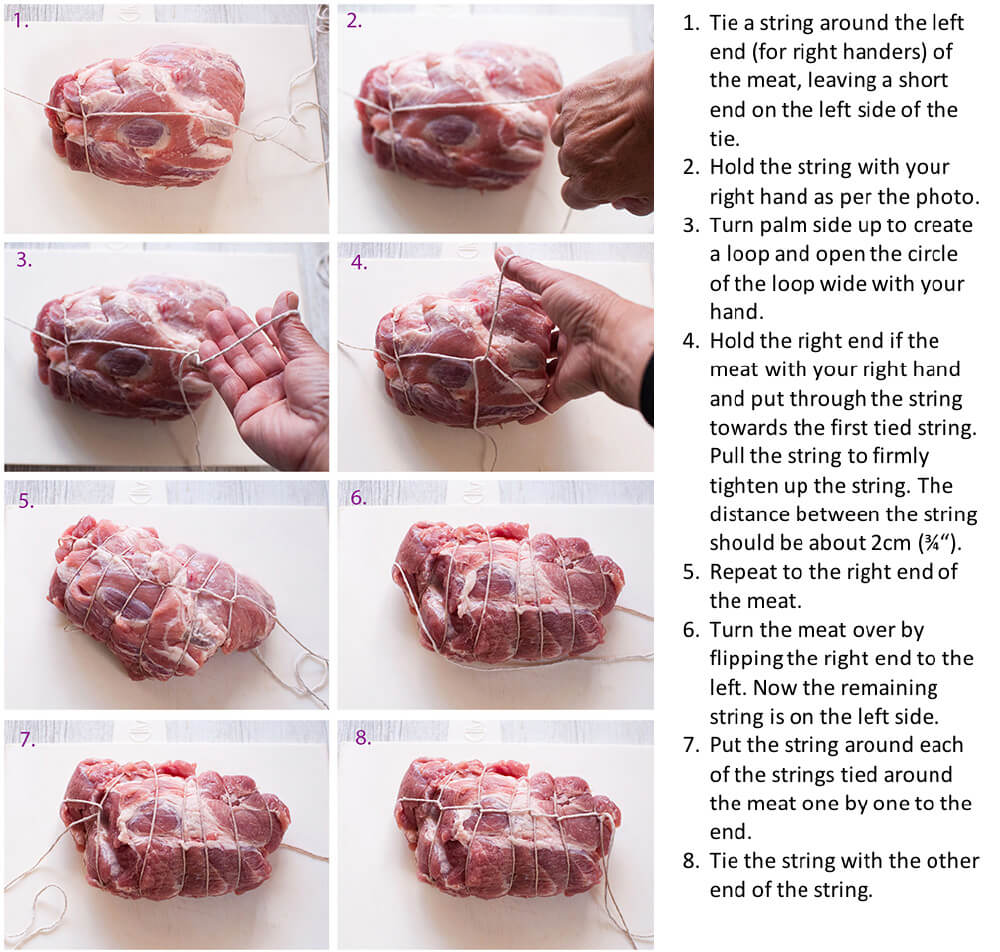
Before cooking the meat in the flavoured sauce, the meat needs to be charred to seal it. Use a non-stick frypan to cook all around the meat including the sides, until the meat becomes a burnt brown colour (see the top photo below).
Then cook the meat in a pot with water, soy sauce, sake, sugar, crushed ginger and shallots (scallions) for a couple of hours. To let the flavour of the sauce penetrate into the meat further, I leave the meat in the sauce for few hours to overnight in the fridge after cooking.
I remove the string after chilling in the fridge (see the bottom photo below). The meat is quite tender and could break if you try to remove the string while still hot or even warm. Then slice the meat as you wish. Yum!
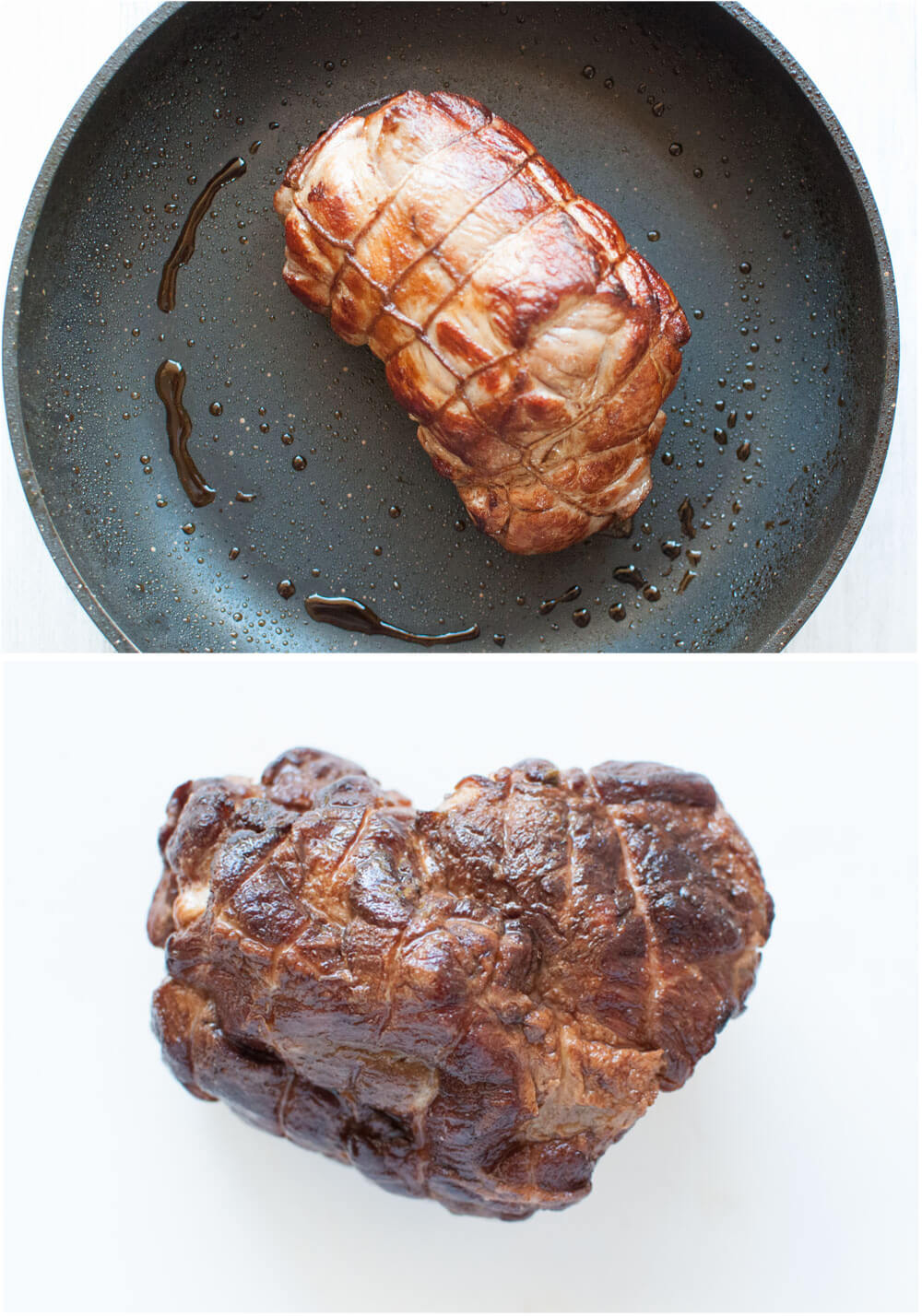
In my household, yakibuta is not served hot. It is served either at room temperature or even cold straight from the fridge. You can either leave the meat on the kitchen bench for a while or microwave slightly if in a hurry to bring it to room temperature.
You will have quite a lot of sauce left over from yakibuta. The meat should have sufficient flavour in itself but if you wish, you could pour a small amount of the sauce over it.
I once condensed the sauce to 250-300ml (8.5-10oz) and kept it for later use such as soy base for ramen soup, substitute to teriyaki sauce.
Another way of making use of the leftover sauce is to make soy sauce marinated boiled egg. It is called “yudetamago no shouyu-zuke ” (ゆで卵の醤油漬け). Yudetamago (ゆで卵) means boiled egg and shouyu-zuke (醤油漬け) is marinated in soy sauce. It is best to make the boiled egg with a slightly runny egg yolk in my view but it is up to you. Simply place the peeled boiled egg in the sauce from the yakibuta (before condensed) and leave it for few hours up to overnight.
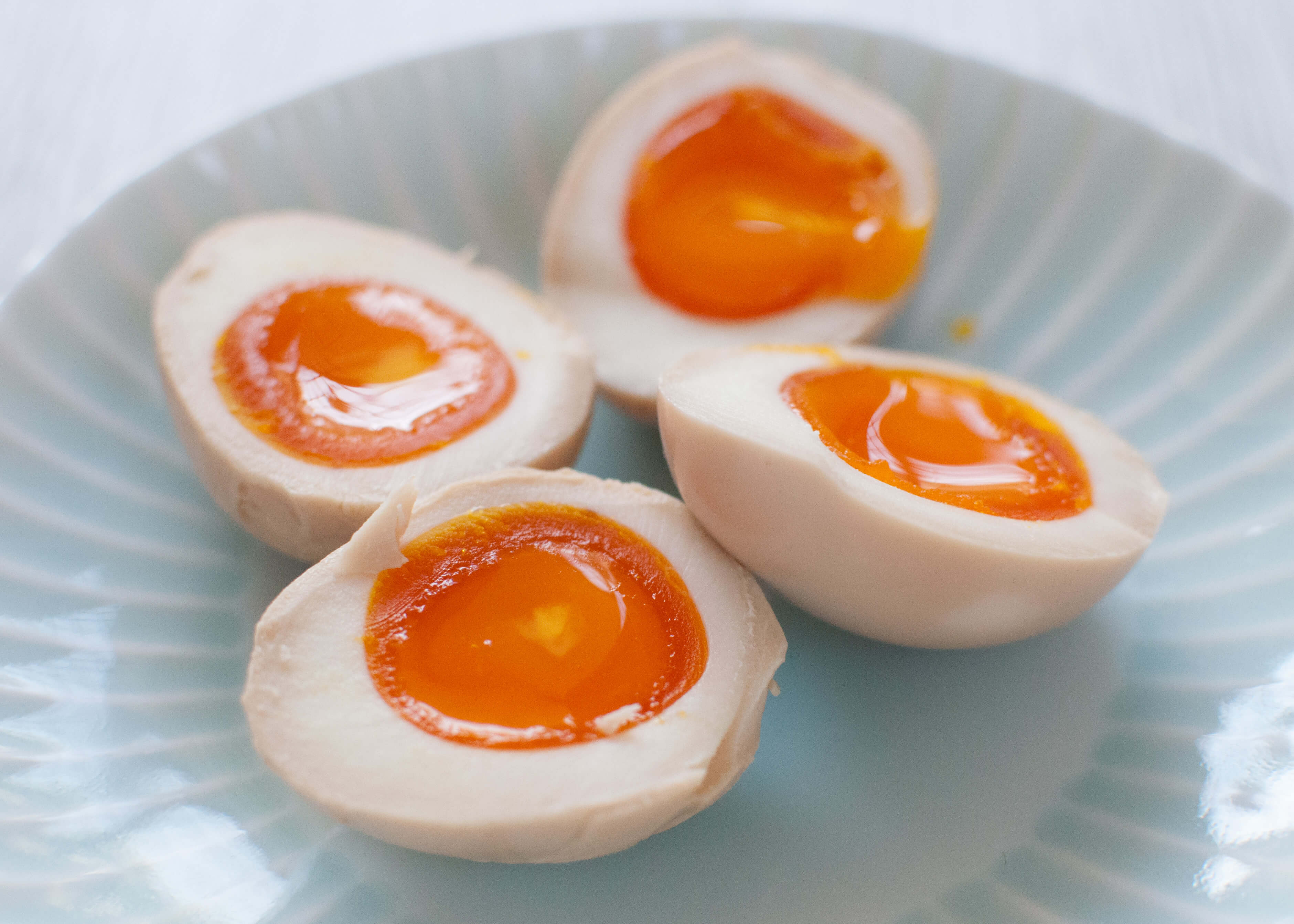
Thinly sliced yakibuta is great for ramen topping. Standard ramen always comes with a couple of slices of yakibuta. I make ramen often for my breakfast or lunch. Yes, I eat ramen for breakfast and all my kids shake their heads with disbelief (meaning “how come such an old woman can eat ramen in the morning?”).
I am planning to post a quick ramen recipe using this yakibuta in a month or two when summer in northern hemisphere is over.
You can also place sliced yakibuta on hot rice and make yakibuta-don (焼き豚丼). The photo below is the example of yakibuta-don which my son made. When I cooked yakibuta with pork belly, I gave most of them to my son who lives close to me. With just few slices of yakibuta, you can make such a good looking rice dish. Pour some yakibuta sauce over the rice before placing toppings.
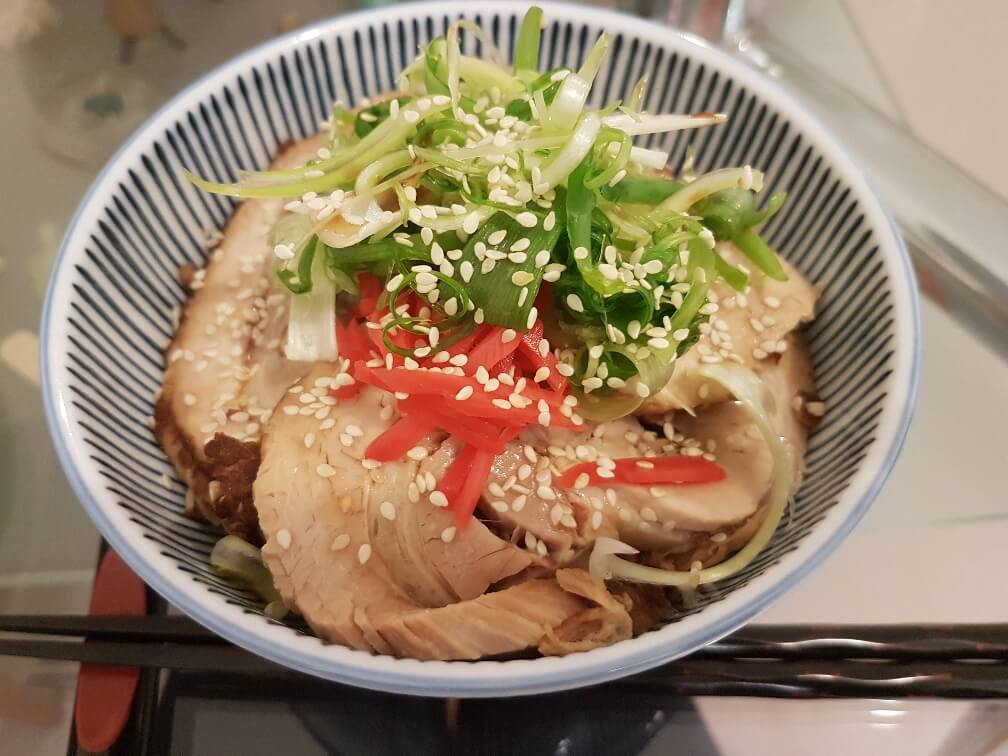
If you can’t consume yakibuta at once, you can freeze it after slicing. If you are likely to use frozen sliced yakibuta in small amount, I’d suggest that you place baking paper between the slices so that you can remove each slice easily.
Yumiko![]()
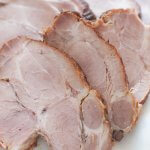
Yakibuta (Braised pork) is a chunk of pork cooked in soy flavoured sauce over a couple of hours. It takes time to cook but it is quite simple to make. The flavour penetrates into the meat and the meat is so tender and flavoursome. Slice thinly to serve as a main dish, appetiser at room temperature or cold. It is a popular topping for ramen.
Total time does not include time to marinate the meat after cooking.
- 950~1000 g (2.1~2.2lb) block of pork scotch fillet (also called pork neck/pork collar/pork butt) tied with butcher’s twine (note 1)
- 1 tbsp oil
- 2 stems shallots (scallions) cut into 2-3 pieces, then bruised (note 2)
- 3 cm (1¼") cube ginger , sliced or crushed
- 150 ml (5.1oz) sake
- 300 ml (10.1oz) soy sauce
- 80 g (2.8oz) sugar
- 1000 ml (1.1qt) water
-
Add oil in a frypan over high heat. Place pork in and brown all over including sides. (about 5 min).
-
Transfer the pork to a deep pot, add the remaining ingredients and bring it to a boil.
-
Reduce heat to low and boil for 2 hours. Depending on the thickness of the meat, the cooking time varies (note 3). When a bamboo skewer can get through the meat easily, it is ready.
-
Cool down the pot slightly then transfer the meat to a large zip lock bag or a container which just fits the meat with sufficient height (note 4).
-
Pour the sauce from the pot into the bag/container so that the sauce covers the meat completely (note 4). Leave it overnight in the fridge.
-
Remove the meat from the bag/container onto a cutting board. Cut the string in several places and remove it gently.
-
Slice the meat to your liking. I usually slice it into 7-10mm (¼ - ⅜”) thick pieces (note 5).
-
Serve with vegetables on the side.
1. You can use a pork loin block or a sheet of pork belly. If using pork belly, remove the skin and roll the sheet to make a log, then tie it. To tie the meat, please see the photo steps at the end of the notes.
2. To bruise the shallots, press the white part of the stem with the side of the knife and crush.
3. I cooked 2 hours for about 1kg (2.2lb) meat. The thickness of the meat was about 10cm (4") in the middle before tied. If your meat is thinner or smaller, it will require slightly less time to get the meat tender. If the meat is larger/thicker, it will take longer. Check if a bamboo skewer can get through it easily.
When I cooked a pork belly which was about1.4kg (3lb) and rolled into a log of 12cm (4½") diameter, it took 3 hours.
Depending on the size of your pot and the strength of the heat, the liquid might reduce too fast. Check occasionally and if required, add some water.
4. It is important to cover the meat with the sauce completely otherwise the part of the meat that did not get marinated will have less flavour.
If using a zip lock bag, try to remove the air in the bag as much as possible. To do this, fill the sink with water as deep as possible, seal the zip leaving 1cm unzipped, then place the bag in the sink. Due to the pressure under the water, the air inside the bag gets pushed to the top. Let go of the air as much as you can and seal the small opening of the zip.
If using a container, try to use a container which just fits in the meat but sufficient height to cover the height of the meat. With my meat, I could have used a large pickle bottle.
If you cannot cover completely, then I would recommend that you turn the meat over occasionally.
5. If I am using the yakibuta as ramen topping, I will slice it thinner.
6. If you can't consume yakibuta at once, you can freeze it after slicing. If you are likely to use frozen sliced yakibuta in small amount, I'd suggest that you place baking paper between the slices so that you can remove each slice easily.
How to Tie Meat

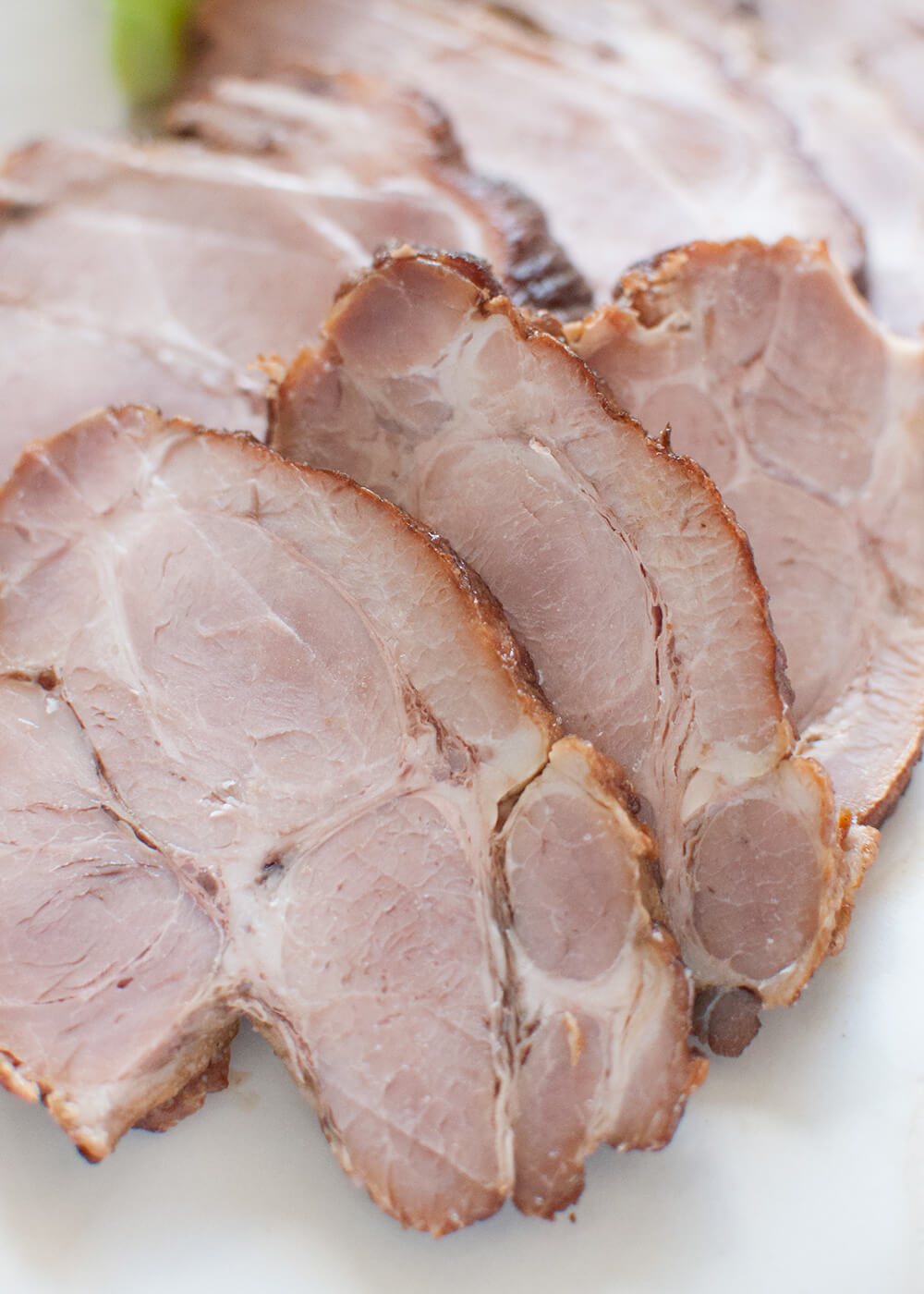
Hi Nagi’s mum Yumiko, I ve read this pork “not actual name charsiu” many time finally I ve made yesterday, having with your quick Ramen recipe, they were absolutely tasty bloody good. Can’t wait next week made with porkbellly. Thank you so much.
Nagi recipe save my life everyday , my three kids love my cooking (actually is from Nagi tin eats blog) haha not me, I never cook before kids, but now I m a best cook for my family 3 hungry teenager. Love you guys
Hi Ai, thank you and that’s wonderful hear that you are now the best cook for your family.
After bringing to a boil and then turning to low, do you put a lid on the pot?
Hi Jo, I did not put a lid on. But depending on the surface area of your pot and the heat strength, the liquid might reduce too fast. You may want to check it from time to time and add some water if needed.
Thanks for asking. I just added this in the note.
I bought a rectangle piece of pork belly for this. It has the skin attached. Do I remove that before rolling it up? It’s a necessity when making a crispy pork belly but what do I do with it when making this? Thanks.
Hi Monie, you want to remove the skin before rolling it up. The skin becomes like a rubber when simmered like this. I should have mentioned this in the note. I will update it. BTW, I usually bake the skin with salt and a bit of oil in the oven and make crispy pork crackling. Yum!
I notice that you use sake and mirin on some of these recipes. Why? I thought mirin was a less alcoholic more sugary type of sake, like a cooking sake instead of a drinking one, why do you use both?
Hi Marcos, it is a good question. In short, sake gives great flavour to the ingredients, while mirin gives shiny texture to the ingredients due to sugar contents. Depending on the type of sake/mirin you use, the alcohol % also varies. Eg. cooking mirin hardly contains alcohol.
Thank you for clarifying this, Yumiko. I have wondered about this in the past (whether mirin and sake were interchangeable) and thankfully Marcus asked the question. 🙂 Great answer.
🙂
Hey yumiko, I thought yaki means grilled.
Hi Derek, you are right.Yaki (焼き) means grilled or roasted in oven. In my post, I touched on how confusing the name of this dish is. It’s probably named because the pork is seared in the beginning before braising.
Hello and Good Day. Thank for the recipe! I can’t wait to try it! What brand of Sake do you use?
Hi Gabriel, I use Takara brand. Takara cooking sake does not contain salt unlike some others.
Thank you!
Hi, would you been able to recoomend or share the brand of soy sauce you use? Thanks
Hi, I use either Kikkoman brand or Higashimaru brand. Both of them are Japanese soy sauces.
Hi Yumiko, thanks for sharing the great recipe! It looks so simple and i will try it this weekend. But i want to ask you, can I substitute sake with chinese wine?
Thanks!!!
Hi Linda, you can use Chinese wine in place of sake. It will taste slightly different (more Chinese-like flavour) but it’s OK.